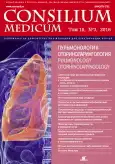Therapy of acute respiratory diseases with those operating under conditions of low intensity occupational hazards
- Authors: Logvinenko I.I1,2, Voevoda M.I1,2
-
Affiliations:
- Research Institute of Therapy and Preventive Medicine
- Novosibirsk State Medical University
- Issue: Vol 18, No 3 (2016)
- Pages: 24-29
- Section: Articles
- URL: https://journals.rcsi.science/2075-1753/article/view/94428
- ID: 94428
Cite item
Full Text
Abstract
Full Text
##article.viewOnOriginalSite##About the authors
I. I Logvinenko
Research Institute of Therapy and Preventive Medicine; Novosibirsk State Medical University
Email: 111157@mail.ru
д-р мед. наук, проф., вед. науч. сотр. лаб. профилактической медицины ФГБНУ НИИТПМ, ГБОУ ВПО НГМУ 630089, Russian Federation, Novosibirsk, ul. Borisa Bogatkova, d. 175/1
M. I Voevoda
Research Institute of Therapy and Preventive Medicine; Novosibirsk State Medical University
Email: mvoevoda@ya.ru
чл.-кор. РАН, д-р мед. наук, проф., дир. ФГБНУ НИИТПМ, ГБОУ ВПО НГМУ 630089, Russian Federation, Novosibirsk, ul. Borisa Bogatkova, d. 175/1
References
- Программа развития ООН. Индекс человеческого развития в странах мира в 2014 году. [Электронный ресурс]. Центр гуманитарных технологий. 24.07.2014. URL: http://gtmarket.ru/news/2014/07/24/6843
- О состоянии санитарно - эпидемиологического благополучия населения в Российской Федерации в 2013 году. Государственный доклад. М.: Федеральная служба по надзору в сфере защиты прав потребителей и благополучия человека, 2014; с. 191.
- О состоянии санитарно - эпидемиологического благополучия населения в Российской Федерации в 2014 году. Государственный доклад. М.: Федеральная служба по надзору в сфере защиты прав потребителей и благополучия человека, 2015; с. 206.
- О состоянии санитарно - эпидемиологического благополучия населения в Новосибирской области в 2014 году. Государственный доклад. Новосибирск: Федеральная служба по надзору в сфере защиты прав потребителей и благополучия человека, 2013; с. 239.
- Львов Н.И., Писарева М.М., Мальцев О.В. и др. Особенности этиологической структуры ОРВИ в отдельных возрастных и профессиональных группах населения Санкт-Петербурга в эпидемический сезон 2013-2014 гг. Журн. инфектологии. 2014; 6 (3): 62-70.
- Малкоч А.В., Анастасевич Л.А., Боткина А.С. Острые респираторные заболевания и возможности иммуномодулирующей терапии. Лечащий врач. 2008; 8: 58-62.
- Жукова Л. Дифференциальный диагноз, лечение и профилактика острых респираторных вирусных инфекций. Врач. 2010; 10: 2-6.
- Кузнецова О.Ю., Плешанова Ж.В. Место современных комбинированных препаратов в лечении острых респираторно - вирусных инфекций в амбулаторной практике // Consilium Medicum. 2010; 12 (3): 93-102.
- Малышев Н.А., Колобухина Л.В., Меркулова Л.Н., Ершов Ф.И. Современные подходы к повышению эффективности терапии и профилактики гриппа и других острых респираторных вирусных инфекций // Consilium Medicum. 2005; 7 (10): 831-5
- Ершов Ф.И., Тазулахова Э.Б. Индукторы интерферона - новое поколение иммуномодуляторов. Terra Medica. 1998; 2: 2-7.
Supplementary files






